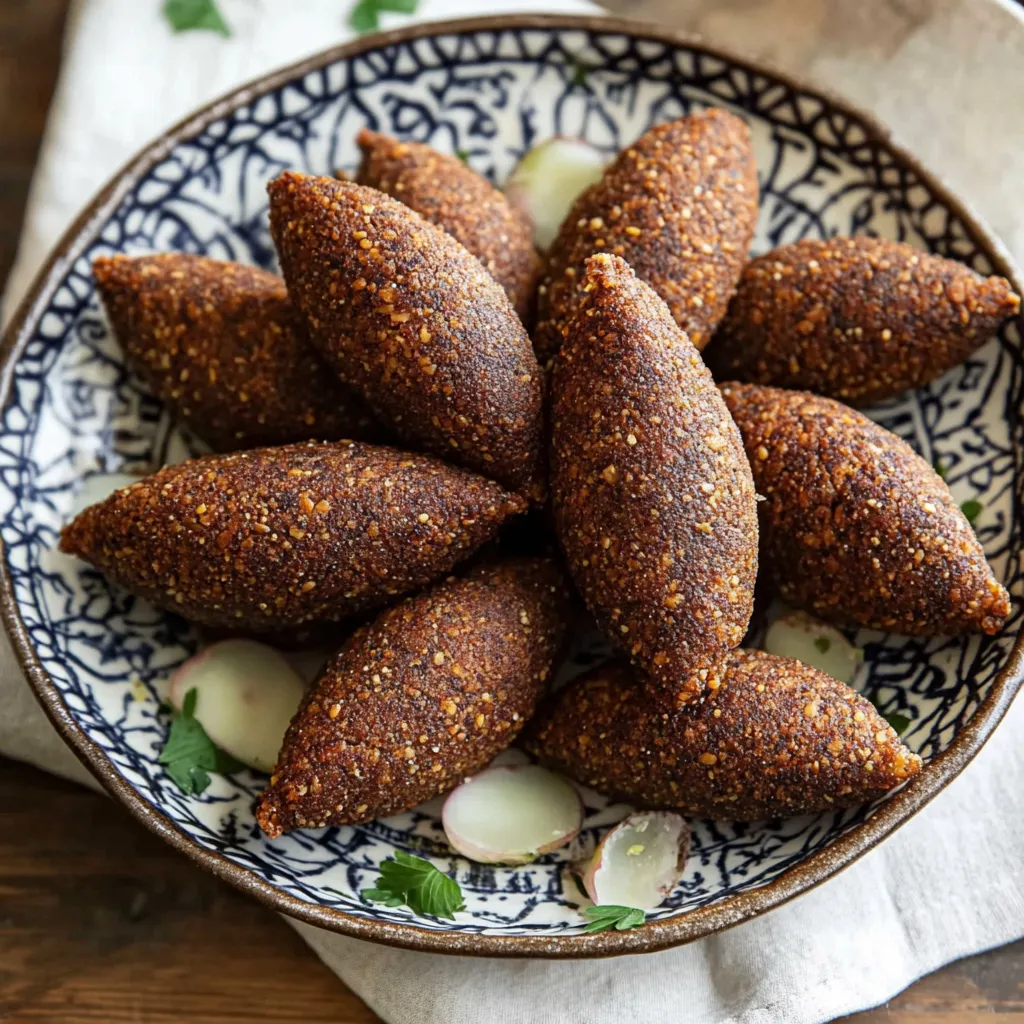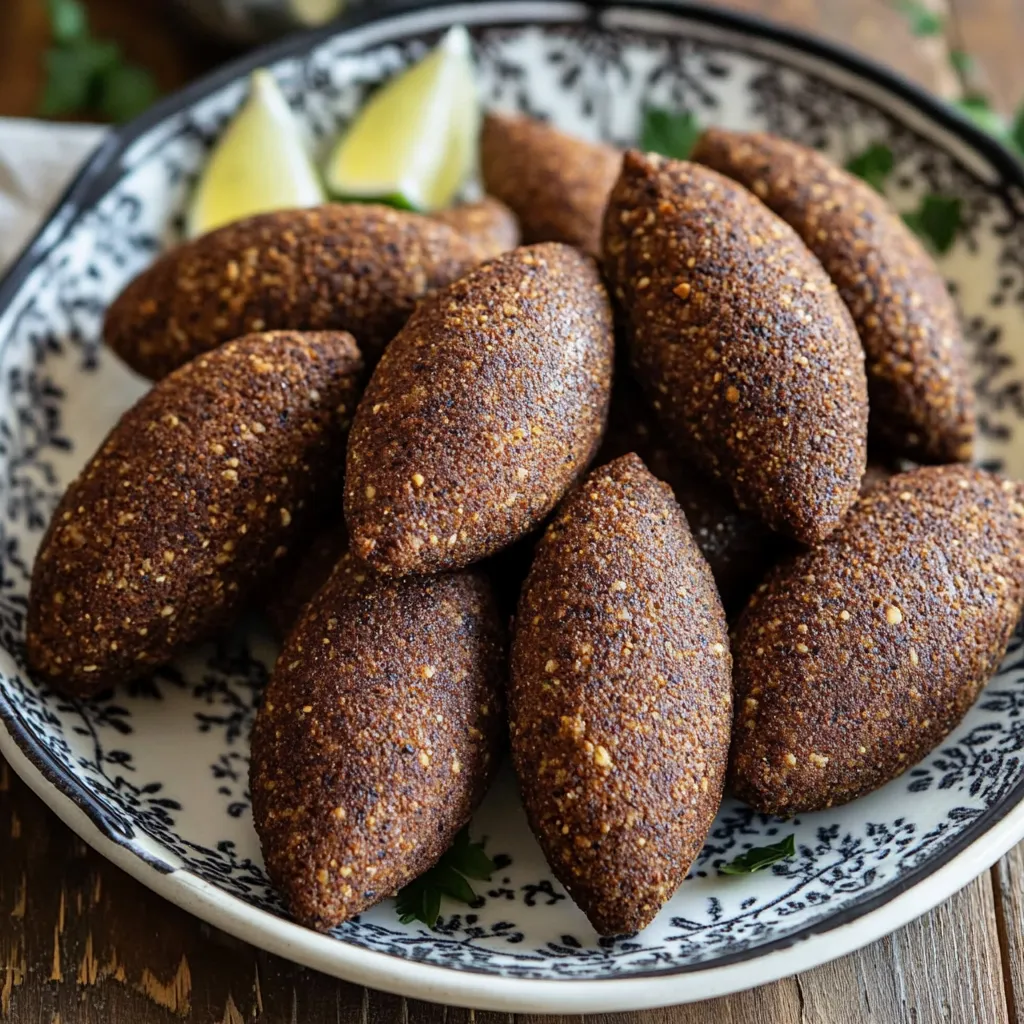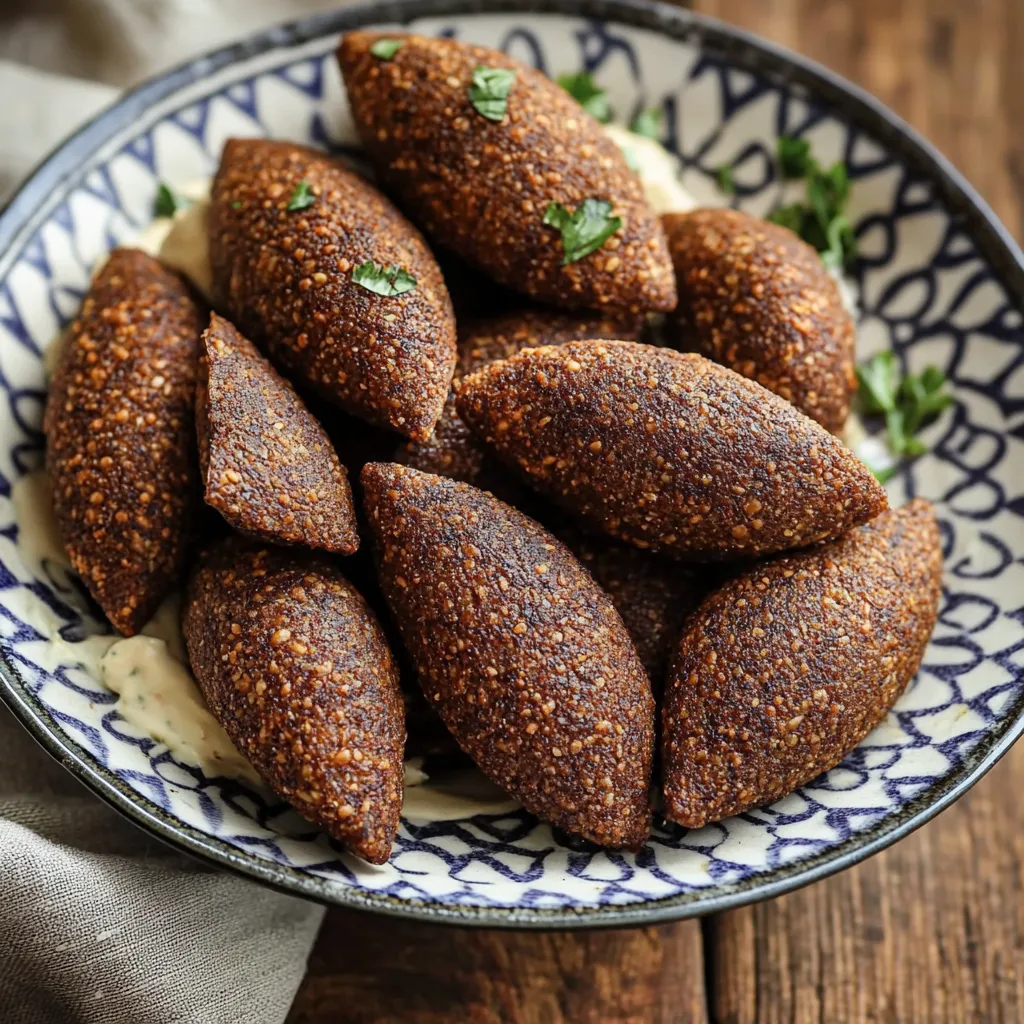 Pin it
Pin it
This Lebanese kibbeh recipe brings authentic Middle Eastern flavors right to your home kitchen. The layered dish combines seasoned ground meat with bulgur wheat and aromatic spices for a truly memorable meal that's easier to make than you might think.
I first learned to make kibbeh from my Lebanese neighbor who insisted the secret was in how you layer the ingredients. After years of perfecting my technique, this version consistently earns compliments when I serve it at dinner parties.
Ingredients
- Bulgur Wheat: Provides the distinctive texture and nutty flavor that makes kibbeh authentic. Look for medium grind for best results
- Ground Beef or Lamb: Creates the rich meaty flavor. Choose 80/20 fat content for optimal moisture and flavor
- Onion: Adds essential aromatics. Select firm onions without soft spots for best results
- Fresh Mint Leaves: Bring brightness to balance the earthy spices. Choose vibrant green leaves without wilting
- Kamouneh Spice Blend: Combines cumin, cinnamon and allspice for authentic flavor. Toast spices briefly before using for enhanced aroma
- Pine Nuts: Add delightful crunch and buttery flavor to the filling. Look for golden color without any rancid smell
- Olive Oil: Helps bind ingredients and adds richness. Use extra virgin for best flavor
- Ice Water: Is crucial for proper shaping. Keep it very cold for best handling
Step-by-Step Instructions
- Prepare the Bulgur:
- Soak bulgur wheat in cool water for exactly 10 minutes until slightly softened but still firm. Drain thoroughly using a fine mesh strainer, pressing gently to remove excess moisture. Fluff with a fork to separate grains and prevent clumping.
- Create the Kibbeh Base:
- Combine soaked bulgur with finely minced onion, freshly chopped mint leaves, and kamouneh spice blend in a food processor. Pulse until mixture begins to come together but still maintains some texture. Add small amounts of ice water as needed until mixture holds together when pinched between fingers.
- Prepare the Filling:
- Heat olive oil in a skillet over medium heat until shimmering. Add finely chopped onion and cook for 4 minutes until translucent and fragrant. Add ground meat, breaking up with a wooden spoon until completely browned with no pink remaining. Stir in toasted pine nuts and season with salt and pepper. Remove from heat and allow to cool completely.
- Assemble the Kibbeh:
- Divide kibbeh mixture in half. With dampened hands, press first half firmly into bottom of greased baking dish, creating an even layer approximately half inch thick. Spread cooled meat filling evenly over first layer, leaving quarter inch border around edges. Cover with remaining kibbeh mixture, smoothing top with wet hands to create a seamless surface.
- Score and Bake:
- With a sharp knife, score top layer into traditional diamond pattern, cutting about halfway through to the filling. Brush surface lightly with olive oil for beautiful browning. Bake in preheated oven for 35 to 40 minutes until deeply golden on top and cooked through.
 Pin it
Pin it
My grandmother always insisted that working the kibbeh mixture with ice water was the key to perfect texture. She would dip her hands in ice water between handling portions to keep the mixture from sticking. This simple trick makes shaping so much easier and results in better texture after baking.
Authentic Variations
The baked kibbeh described in this recipe is just one wonderful version of this versatile dish. In Lebanon, you'll find kibbeh prepared in numerous ways. Some families make kibbeh nayeh, a raw version similar to steak tartare, served with olive oil and fresh herbs. Others shape the mixture into hollow football shapes filled with the meat mixture, then deep fry them for kibbeh maklieh. Each family typically has their own special preparation method passed down through generations.
Serving Suggestions
Kibbeh pairs beautifully with traditional accompaniments that balance its rich flavors. Serve with a side of cool, tangy yogurt sauce mixed with cucumber and mint. A simple salad of tomatoes, cucumbers and parsley dressed with lemon juice and olive oil makes a perfect fresh counterpoint. For an authentic Lebanese spread, include warm pita bread, hummus, and tabbouleh on the table. The contrast of temperatures and textures creates a memorable dining experience.
Storage and Reheating
Store leftover kibbeh covered in the refrigerator for up to three days. The flavors actually develop and improve overnight, making this a perfect make-ahead dish. To reheat, cover with foil and warm in a 300°F oven for about 15 minutes until heated through. For best texture, avoid microwave reheating which can make the bulgur tough. Kibbeh also freezes remarkably well either before or after baking. Wrap tightly in plastic wrap and foil, then freeze for up to three months.
 Pin it
Pin it
This recipe will quickly become a family favorite, bringing a taste of Lebanon to your table.
Frequently Asked Questions
- → What is the best type of meat to use for kibbeh?
Traditionally, Lebanese kibbeh is made with either ground lamb or beef. Lamb provides a more authentic flavor, but beef works excellently too. If you prefer leaner options, ground turkey or chicken can be substituted, though they will produce a slightly different flavor profile.
- → Can I prepare kibbeh in advance?
Yes! Kibbeh is perfect for make-ahead meals. You can assemble the entire dish, cover it tightly, and refrigerate for up to 24 hours before baking. Alternatively, you can freeze the assembled but unbaked kibbeh for up to 3 months. When ready to serve, simply bake directly from frozen, adding about 15-20 minutes to the cooking time.
- → What is kamouneh spice and what can I use instead?
Kamouneh is a traditional Lebanese spice blend typically containing cumin, cinnamon, and allspice. If you can't find it, make your own substitute with 1 teaspoon cumin, ½ teaspoon cinnamon, and ½ teaspoon allspice as mentioned in the ingredient list. This will provide the authentic aromatic flavor profile.
- → How do I know when kibbeh is properly cooked?
Properly cooked kibbeh should have a golden brown top and should be firm to the touch. The internal temperature should reach about 160°F (71°C) when tested with a meat thermometer. The scoring on top should look crisp, and there should be a pleasant aromatic smell when it's done.
- → What are traditional accompaniments for kibbeh?
Kibbeh is typically served with cooling sides like yogurt sauce (labneh), tabbouleh salad, or a simple cucumber and tomato salad. It also pairs well with warm pita bread, pickled vegetables, and olives. For a complete Lebanese meal, consider serving it alongside hummus and baba ganoush.
- → Can kibbeh be made gluten-free?
Yes, kibbeh can be adapted for gluten-free diets by substituting the bulgur wheat with quinoa, as mentioned in the ingredient substitutions. Ensure the quinoa is well-rinsed, cooked until just tender, and drained thoroughly before using. The texture will be slightly different but still delicious.
